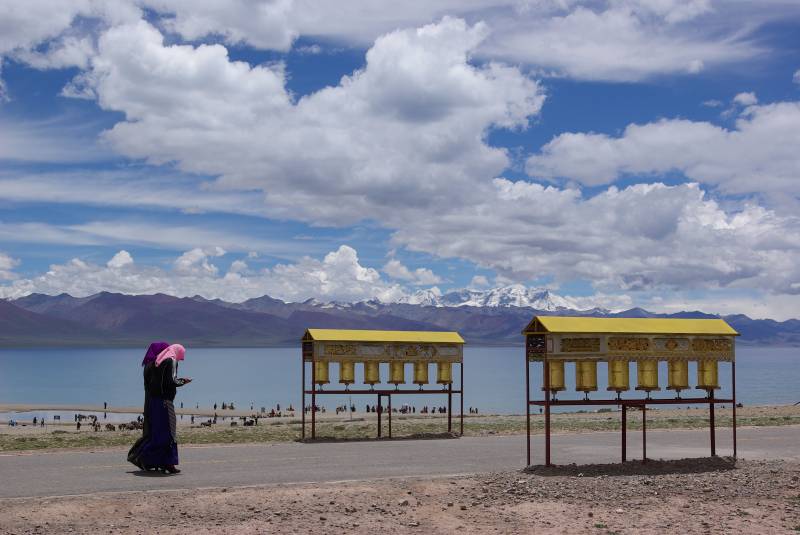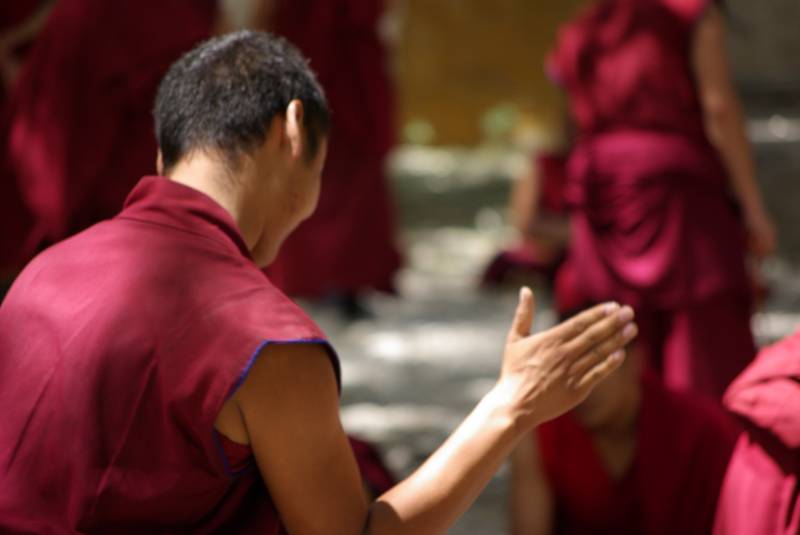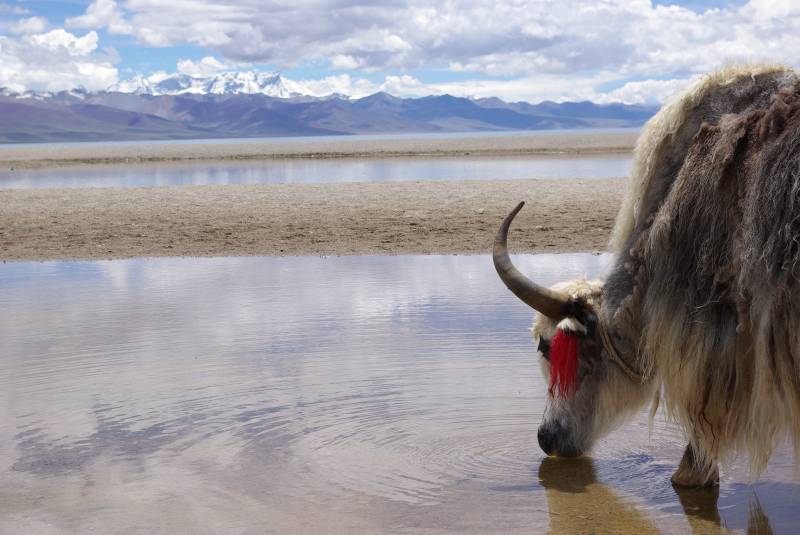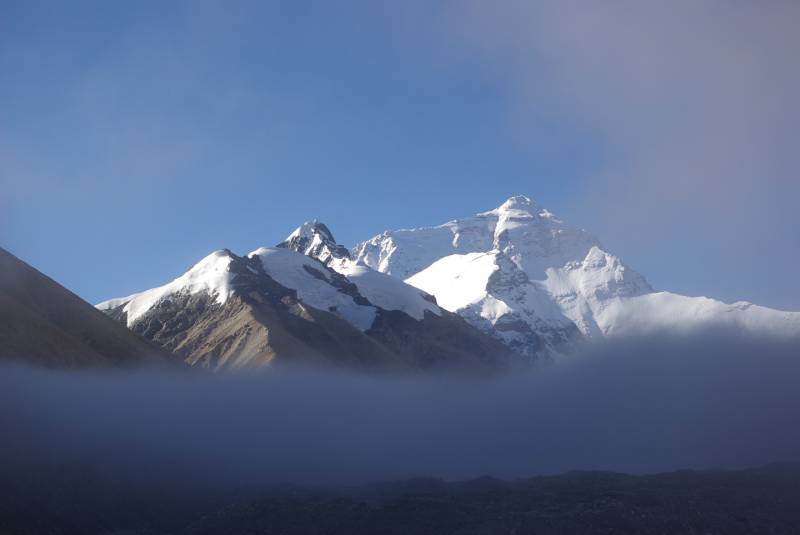
Prayer wheels by Namtso lake at 4700m.
We flew in to Lhasa in Tibet at 3700 meters, and spent the first day taking it easy to get used to the altitude. Lhasa today looks like any other modern booming Chinese city, and in most areas there’s little to remind you that you’re in Tibet at all if you’re not in view of the Potala palace. The exception is Barkhor, a Tibetan quarter where the old buildings have survived, and we checked in to a hostel nearby together with our two Austrian travel buddies for the next 8 days. Even nearly 60 years on the area still feels like occupied territory, soldiers in riot gear with automatic weapons on the street corners, roof-tops, and marching up and down the Tibetan quarter. We walked around the souvenir stalls and markets of Barkhor in the evening before starting proper sightseeing the next day. Outside the Jokhang temple in Barkhor pilgrims from all over Tibet were prostrating and praying, a few even prostrating themselves the whole length of the kora around town. Barkhor was fairly crowded with tourists (we had failed our usual policy of always timing off-season), probably 90-95% Chinese domestic tourists plus a few westerners – similar to what we saw in Leshan and Mount Emei and again same as there many of the Chinese tourists like travelling in big groups all following a person with a flag and megaphone.

In the Jokhang monastery in Lhasa.
We started the second day with visiting the Potala palace, former home of the Dalai Lama and Tibetan government as well as monastery, now turned into a kind of museum with about 50 of the 1,000 rooms open to tourists. Visits by foreigners is one thing that’s gotten stricter since our guidebook was printed – you’re allocated a timeslot of 60 minutes to cover the inside together with your guide (entrance to any Lhasa monastery, or simply being anywhere outside Lhasa, requires an official guide since the Olympics), and there’s an airport-style checkin with bag x-rays and no water bottles allowed. The palace was built in the 1100’s, and unlike most of Tibets monuments survived the Cultural Revolution quite well – the Norbulingka summer palace for example was converted into an army store-house. The monuments and sculptures inside, in memory of various lamas or Indian scholars or the present or future Buddha, are amazingly impressive – some covered with several tonnes of leaf gold, but the place feels like an empty shell with big tour groups rushing through and the caretaker monks not allowed to wear their robes etc. I felt a pang of sadness when we passed by the Dalai Lamas small bed-and-study room, recalling his memoirs where he talked of being an undisciplined young student as a child, climbing around on his mentors telling them to recite instead. They’ll never allow him to return. Outside in the gardens surrounding Potala, as a final humiliation, they’re pumping out Chinese music on loudspeakers everywhere and you can rent a duck-shaped paddle-boat to go on the lake.. Many pilgrims still do come and complete a kora around the palace (and at least they don’t have to pay full entrance fee to go inside) – the walk in front of the palace passes by a big “People’s Park” concrete square built just across the road, with a monument celebrating the moment of Tibet’s “liberation”, when hundreds of thousands of Tibetans were liberated from their earthly existence.

Outside Drepung monastery.
After Potala we went to the Jokhang monastery in Barkhor. More atmospheric than Potala, with pilgrims (some looking like they travelled for weeks over the mountains to get there) scooping yak butter into the big butter lamps burning inside the monastery or leaving small bills of money by each statue. It still had the big noisy tour groups as well though. Next day – more monasteries! First the Drepung which sits on top a hill 8km from Lhasa, it was once the worlds largest monastery with 10,000 monks – a few hundred are allowed to study there today. Things have improved in general in Tibet starting in the 80’s with many monasteries now being restored or rebuilt after having been flattened during the Cultural Revolution, and are now allowed to take in a small percentage of the number of monks who used to live there – provided they denounce the Dalai Lama and devote part of their study time to political party propaganda.. From Drepung we walked down the hill to Nechung monastery. Visiting so many monasteries they do risk blending in to each other after a while, but this one does stick out. Spookily decorated with demons and horrors of another world, it was once home to Drakden the state oracle of Tibet.

Monks debating in the Sera monastery.
Next day: Sera monastery – here we saw monks debating in a courtyard in the special traditional style including a handclap to punch in each argument. It was a bit of a tourist spectacle as they were surrounded by people snapping away on their cameras, but of course I was one of them. Here’s a picture 🙂
Next day we took a short break from monasteries to go to Namtso lake 230 km from Lhasa – the lake lies at 4700m altitude and the highest pass on the way was 5150m – we did feel the altitude a bit on the way. The lake is absolutely stunning, incredibly blue as it reflects the bright Tibetan skies. We spent an hour or so taking photos and walking by the lake, and huffing and puffing our way up a hill filled with prayer flags nearby for even bigger views. Lunch by the lake was interesting, possibly the worst English we’ve seen on a menu so far, combined with some for us somewhat unusual ingredients..”Sliced Pork’s Guts“, “Cooled Pork’s Forgive“, “Roofs with vine gal sauce“, “Saeef snshewnufs” (maybe something with cashewnuts?). We went for the vegetarian option this time.. On the way back we got stuck in some road-works with a mile-long queue and our driver decided to test the off-road option with just one big river to cross – luckily a government vehicle had already “tested the waters” and gotten itself stuck about 2 meters after leaving the river bank. The water was up to the windshield and three people were stuck sitting on the roof – looked quite dangerous as the river was way too fast to swim even if they knew how to. A crowd had gathered on each side, with ropes and helpful ideas – we were on the opposite bank so could do nothing – our driver and guide sat down with some tea to watch! Eventually the three were rescued in the scoop of a big yellow digger, then they set out to rescue the car. This was done using of a method of lifting the car very high with the digger then dropping it front first into the river several times.. It didn’t look particularly effective, but did provide us with some entertainment for the hour or so we were waiting for the road to open. Once it finally did open the first vehicles to be let through were a hundred-long convoy of military trucks going the opposite direction..

Yak by Namtso lake.

At the top of the Gyantse Kumbum.
Next day we started early to begin making our way towards Everest base-camp over the next couple days, stocking up on snacks in the “Family of supermarket common people” store next-door before setting off in the jeep. We passed another big bright-blue high-altitude lake Yamdrok Tso at 4800m, before climbing through several 5000m passes. In general we were surprised how green it was this high up in Tibet – when we were up around 5000m in Bolivia and Peru on the last trip there was almost nothing but desert, but here there is grass, flowers, yaks and herds of sheep looked after by hardy nomads. We stopped in a town called Gyantse on the way, to look at another monastery and climb their gigantic Gyantse Kumbum stupa. There’s around 100 small chapels inside the stupa as you climb the many levels to the top, where you are level with the Buddha eyes looking out over the landscape. Gyantse also has a hill-top fort with an “Anti-British Imperialist Museum” from when they invaded in 1904 (46 years before China), but it was unfortunately closed. From Gyantse we continued on to Shigatse, making a short stop on the way at a water-powered mill making barley flower for the national dish tsampa. After a night in Shigatse we continued on to Everest Basecamp (EBC) the next day, passing several more high passes. One – Lhakpa La at 5270m – is the highest we’ve been anywhere to date. A later pass had good views towards Mount Everest and several more 8000 meter peaks – long serpentine roads after this point started to remind a little of Spiti valley in India three months ago, though the roads or the drops to the side were never as bad here. Actually all the roads until the turnoff to EBC from the “Nepal Friendship Highway” had surprisingly been paved. But while the roads are good what takes time are all the military checkpoints along the way…

Edel at 5000 meter.
We stopped in a tent camp four kilometers from EBC in the evening to spend the night – our first time sleeping above 5000m. I’d been slightly nervous about this – when we hit 4000m the first time on the last trip, in Potosi in Bolivia, we had a miserable first night..the slight feeling of suffocation just when falling asleep as there’s just not enough air in the air..but slept really great this night – must have been well acclimatized by now. The night was cold outside, and with a fantastic clear star-filled sky. We tried yak butter tea in the evening – very unlike anything else that bears the name tea.. It’s salty and so fatty that it feels like you just put on lip balm after a sip. One cup is quite enough, though it wasn’t as horrid as the guide-books had made it out to be. Gave tsampa a test also – it’s the national dish made from barley flour mixed with anything that’s wet..water, beer, or most often yak butter tea, then rolled into balls and eaten with the hands. Quite nice, a little bit peanutty in taste..

Cloudy view towards Everest from the base camp.

North face of Mount Everest.
Next morning we started before sunrise to walk the final stretch to the main basecamp – while the altitude gain is less than 200m it was quite a bit of work. Once there the view towards Everest clouded over immediately..though we waited around in the cold long enough for the clouds to part as the sun rose higher. Absolutely amazing views from a small hill filled with prayer flags by the basecamp, looking up on the worlds highest mountain with another 3-4 kilometers to go to the top. On the way back we stopped at Rongbuk monastery, also the worlds highest at 4980m, where the monks enjoy living with the view towards the north face of Everest towering in the south. Next: more monasteries. Back on the road returning to Shigatse we made a detour to the Sakya monastery. Originally the town held two monasteries, but the northern one which was founded in 1073 was completely destroyed during the Cultural Revolution..the ruins can still be seen across the river from the roof of the now restored southern monastery. This one is from the 1200’s, Mongolian in style so stick out from the other monasteries we’ve seen.

Monastery yak butter lamp.
In Shigatse in the evening after dinner (dahl baht – found a place with Nepali food!) our two travelling companions Sascha and Remy got stuck in a police raid in an internet cafe! The police took about half of the people in there with them.. Internet everywhere in China is filtered of course, blogspot and facebook etc. blocked always and BBC blocked depending on what news stories they’re running at the moment, and maybe access is extra sensitive in Tibet. The main monastery in Shigatse – the Tashilumpo – was to have a big ceremony with the Panchen Lama in two days..could be the reason security was extra tight? We definitely saw a lot of police and military on the streets anyway. The Panchen Lama line has had it difficult, with the 10th one in prison and tortured for over a decade in the 60-70’s after criticizing the conditions in Tibet, and when some years after he died in -89 the Dalai Lama identified his reincarnation this boy and his family immediately disappeared and he was replaced with a Chinese choice..he still hasn’t been seen and the boy is often called the worlds youngest political prisoner. The Panchen Lama that would be visiting the monastery the day after us was of course the Chinese choice, and he’s not generally seen as genuine by the Tibetan people – however the military will make sure at least some people go to see the ceremony… Apart from the tragic background the Tashilumpo monastery (our 9th in Tibet) was very impressive – one building housing a 26-meter golden statue of Maitreya, and atmospheric with monks tending yak butter lamps and pilgrims donating butter and small notes. It always kills it a little for me when I see the monks counting money though..carrying around big buckets of notes or sit around in the chapels counting them.
Once back in Lhasa we had time for a final stroll in Barkhor and a yak burger before leaving on the 47-hour train the next day. Had gotten pretty fond of yak meat at this stage, having tried it in almost every form; yak steak, yak burger, yak dumplings, yak sizzler and yak enchiladas (try to come up with a food-combination further-apart than Tibet-Mexico!). It’s good meat, tasty and without too much fat (..very much unlike the yak butter tea), but I always have to tell myself that the particular restaurant we’re eating in probably didn’t buy it from one of the open-air butchers we see on the street everywhere, sometimes with someone sitting there waving a stick+cloth to keep the flies away, sometimes not..